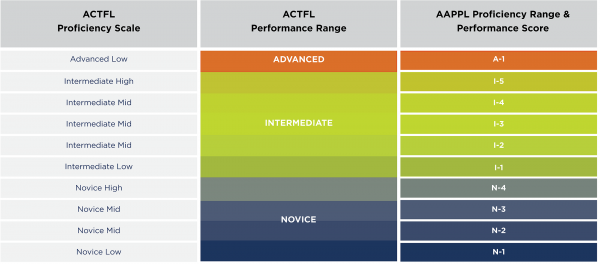In a recent post, we talked about different ways to measure success in dual language programs across areas such as academic achievement, cultural competency, and language learning. We also talked about the difference between performance and proficiency assessments for measuring language acquisition. Spring proficiency testing for 2nd**, 5th, and 8th graders is quickly approaching, so let’s dive in a little further to understand the ACTFL Assessment of Performance Toward Proficiency in Languages (AAPPL).
**2nd grade testing is not required for the 2020-21 school year.
So the AAPPL is both a performance AND a proficiency assessment?
Yes, and there’s an explanation! The AAPPL is technically not 100 percent a proficiency assessment because it covers specific topics that are shared with teachers before testing, and teachers can practice these skills with their students. Especially for younger children, sharing these topics helps students feel more comfortable and confident. After all, the first exit proficiency benchmark set by the North Carolina Department of Public Instruction is at the end of 2nd grade (see page 8), at which point students are usually about eight years old.
The AAPPL balances assessing students on shared topics that they have already covered as part of their standard curriculum (performance testing) with being able to communicate about these topics in real-world contexts (proficiency testing). It’s the difference between, say, being able to match the word elefante to a picture of an elephant on a quiz, and a student being able to tell a video chat partner that their favorite animal is an elephant because they are really big and have long noses. The student technically was able to practice animal vocabulary, but the AAPPL is still able to use their response to assign them a score of one of the ACTFL proficiency levels.
What else do I need to know about the AAPPL?
The AAPPL is made up of four components, or mini-assessments, which target different language skills:
-
-Interpretive listening
-Interpretive reading
-Presentational writing
-Interpersonal listening and speaking**
**Interpersonal listening and speaking is the only skill assessed in 2nd grade.
Students receive a unique score for each of these components that shows their language ability according to the ACTFL Proficiency Scale (see below). With this information, you can then measure your student’s progress between 2nd, 5th, and 8th grade. Because this is an ACTFL assessment, the results of the AAPPL are generally accepted as an official measure of your student’s language abilities.

Why is it important that it’s an official measure?
Depending on your student’s circumstances, having official documentation of their language skills can provide exciting opportunities. For example, some schools use AAPPL results to support a Credit by Demonstrated Mastery (CDM) process, allowing students to place out of one or more levels of language courses (e.g., skipping Chinese 1 in high school and moving straight to Chinese 2). Placing out of pre-requisites is a great way to free up your child’s schedule for other courses they may be interested in!
AAPPL results can also be used in some cases to apply for a state Seal of Biliteracy (the equivalent in North Carolina is the Global Languages Endorsement), which often results in an extra seal on a high school diploma and can be included on college applications if your student chooses that route. In some cases, it may also fulfill college language requirements, meaning fewer hours spent on courses outside of your student’s major…unless your student majors in the language, in which case they have more hours to explore the language more deeply!
Will my student be graded on this assessment?
This decision is up to your child’s teacher and administrator, but we typically do not recommend it. Language acquisition in a dual language program is a years-long process, and not everyone moves at the same pace. Our hope is that this assessment can be used to celebrate your child’s language skills and achievements and provide them guidance on how they can keep growing.
Want to learn more about how specific language skills progress over time? Check out ACTFL’s Performance Descriptors for Language Learners. For more information about Participate Learning’s dual language programs, visit our website or contact us directly.




